To save the seahorses, culture matters
Whenever conservationist Reana Ng walks into a traditional Chinese medicine (TCM) shop, she gets a “look”, she says wryly. “They just know that you’re not coming in to buy traditional medicine... why are you here?”
Undeterred, Ng continues to visit these shops. Since March, this Masters student has been gathering information on the many uses of seahorses and on how people in Peninsular Malaysia use them.
TCM has been used in Malaysia for centuries. Currently, an estimated 6,000 TCM practitioners serve a largely ethnic Chinese clientele.
Seahorses are used in TCM to resolve a very broad range of ailments, including skin conditions, blood cleansing and heatiness (unbalanced yin-yang energy due to too much yang force).
The very first shop Ng visited is what is known locally as a traditional medical hall, with glass-topped counters fronting a prominent dark-brown medicine cabinet with red sunburst-fringing drawer knobs.
Behind the counter is a wizened shopkeeper in a white Pagoda-brand T-shirt tucked into striped pyjama pants. He stares coldly at her, remaining monosyllabic until she identifies herself as half-Chinese (Ng is half-Indian).
So, cultural precepts are the basis for dialogue here, she notes.
The now-amenable practitioner goes to the back and brings out plastic containers of dried seahorses and pipefishes to show Ng.
To her question as to how he sells the fish, whether by piece or weight, he pulls out a brass dang cing (traditional Chinese scales) complete with red tassels, to show her. (The cost is RM1,000 for 300gm of the fish.)
The practitioner also regales her with detailed seahorse-based medical recipes and answers questions about seahorse threats (bycatch is a “minor threat”) and cost (“they’re too expensive”).
For Ng, who is trained in zoology and ecology, the whole experience was an eye-opener into the cultural world of TCM. It is an understanding she is building for her research project, ‘Seahorses: Traditional Medicine, Cultural Values and Trade in Malaysia’.
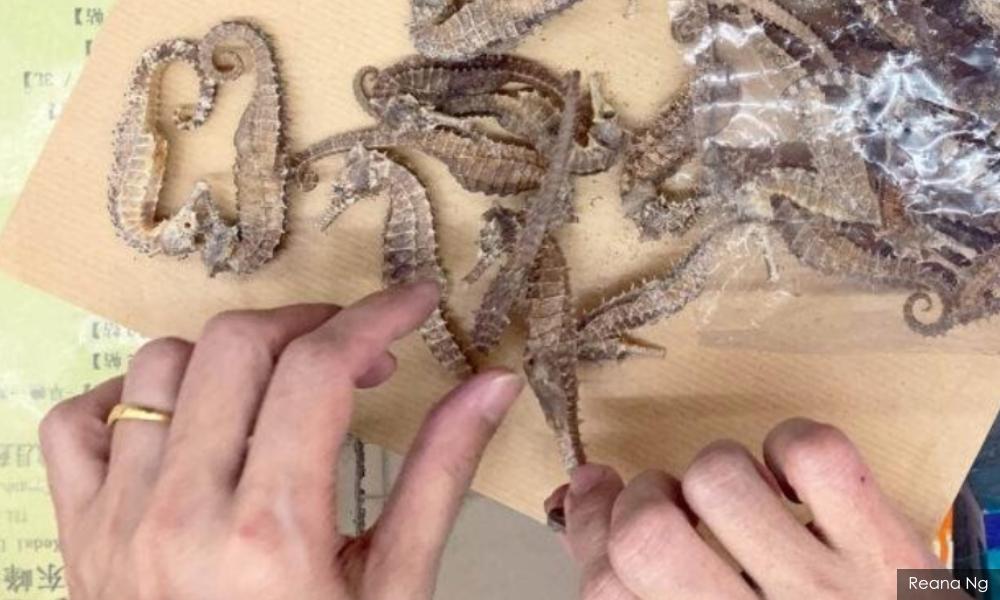
TCM is the most widely known use of seahorses in the world. This is likely true in Malaysia too, but the last published research on this is almost 20 years old.
“Seahorses are traded in our country more than we think,” Ng said.
“Due to the lack of data, it’s perceived as not traded as much compared to pangolins or elephant (ivory).” This, she said, leads to a lack of urgency among stakeholders to conserve seahorses.
For decades, researchers have considered Malaysia to be significant in seahorse exploitation because of its large ethnic Chinese population, extensive seahorse habitats and central location for regional trade.
Locally, seahorses are not targeted by fishers but caught unintentionally as bycatch, particularly through bottom-trawling, which sweeps everything up in large nets. Globally, the UN estimates that trawling results in 4.2 million tonnes of bycatch and discards.
Because Malaysia does not record bycatch in fisheries data, the number of seahorses caught or exported is unknown.
A rough estimate of seahorse catch, derived from global trade figures in 2010, is that almost one million seahorses are caught in Malaysia every year.
It is actually legal to trade seahorses internationally and sustainably under the Convention on International Trade in Endangered Species of Wild Fauna and Flora (Cites).
Seahorses are sought for TCM, as curios and the live aquarium trade.
False impression
However, during her survey of 22 TCM respondents in the Klang Valley, Ng found that most think it is, or might be, illegal to buy and sell seahorses. Anyway, two-thirds of the respondents sold them. Hence, their suspicion of Ng when she went calling.
About half of the respondents personally consume seahorse-based medicines, either in dried form or capsules.
“It keeps me healthy. It has fewer side effects than modern medication,” said one, declining to be identified. “I think that seahorses in traditional medicine work better or just as well as modern medicines.”
Another added that consuming seahorses “is part of my cultural beliefs”.
Seahorses have come under the global conservation spotlight recently.
Experts at an International Union for Conservation of Nature (IUCN) meeting in late 2020 agreed to raise the conservation profile of seahorses and other members of their syngnathid family.
Experts also recommended that iconic species be used “to promote action on broad ocean issues, including climate change”.
Climate change affects seahorses directly, particularly through ocean acidification and warmer seas, disrupting activity levels, feeding and ventilation.
Rising sea levels and intensified rains and storms linked to climate change also impact their habitats, already under threat from unsustainable development and pollution.
Addressing these concerns would address marine health as a whole.
What’s so special about the seahorse?
It is a wonder of nature. A fish with a horse’s head and kangaroo pouch, the male gets pregnant and gives birth, and is monogamous for life.
It confines itself to small areas but in many types of coastal habitats, including seagrass ecosystems, coral reefs and mangroves.
The seahorse helps structure these ecosystems by feeding on bottom-dwelling organisms. Its characteristics make it a cultural icon in many cultures, including in Malaysia.
According to seahorse expert group Project Seahorse: “By getting it right for seahorses – such as setting up marine protected areas, reining in bad fishing practices and regulating wildlife trade – we support thousands of other species.”
Malaysia is key as it sits in a region prioritised by the IUCN for seahorse conservation.
“There are vulnerable species all over the world but we particularly see them in eastern Southeast Asia… commensurate with the fact there are more species in the region,” said IUCN’s Dr Amanda Vincent at a recent global meeting of seahorse experts.
Vincent is chair of the Seahorse, Seadragon and Pipefish Specialist Group of the IUCN Species Survival Commission.
Indeed, Malaysia alone hosts 12 seahorse species, which is over a quarter of all seahorse species.
However, there is data on only five of those species to assess their populations and threats. All five are in danger, said Mohamad Saupi Ismail, Research Director of the Fisheries Research Institute (FRI).
FRI comes under the Department of Fisheries and is Malaysia’s National Scientific Authority for seahorses at Cites.
Outlook grim
“Right now, most of the seahorses in Malaysia fall under the Vulnerable category of the IUCN Red List (of Threatened Species). It’s just a matter of time before one of them becomes a Threatened species,” said Saupi.
At greatest risks are the hedgehog seahorse (Hippocampus spinosissimus) and three-spot seahorse (Hippocampus trimaculatus), because they are heavily traded globally.
Malaysia currently has no strategy for conserving seahorses. But Saupi’s research institute has been breeding seahorses as a conservation measure.
Rows of tanks and sprawling pipes and hoses define the FRI’s hatchery and lab where seahorses have been researched and bred since 2014. The institute is now home to thousands of captive-bred seahorses.
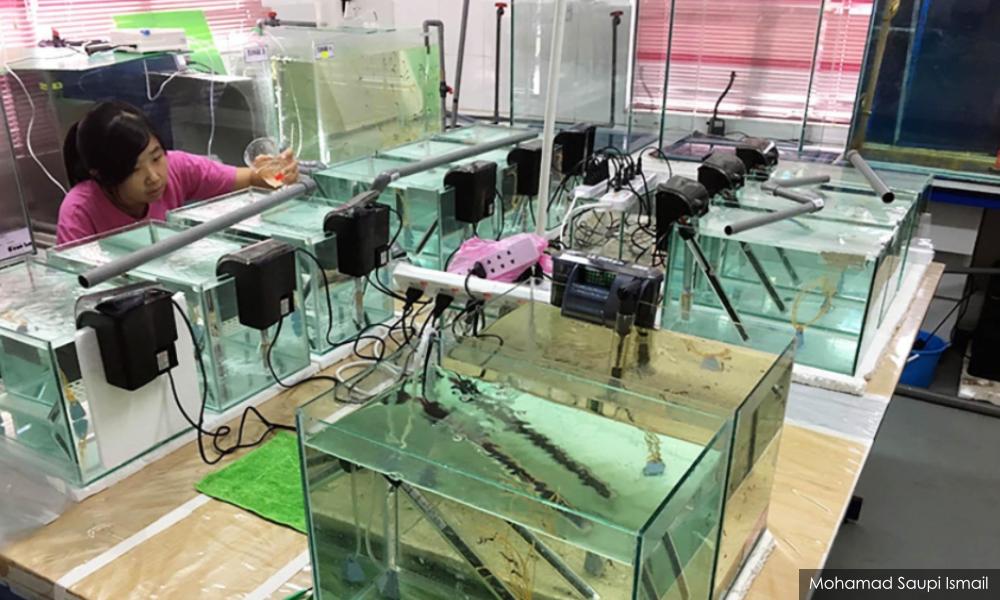
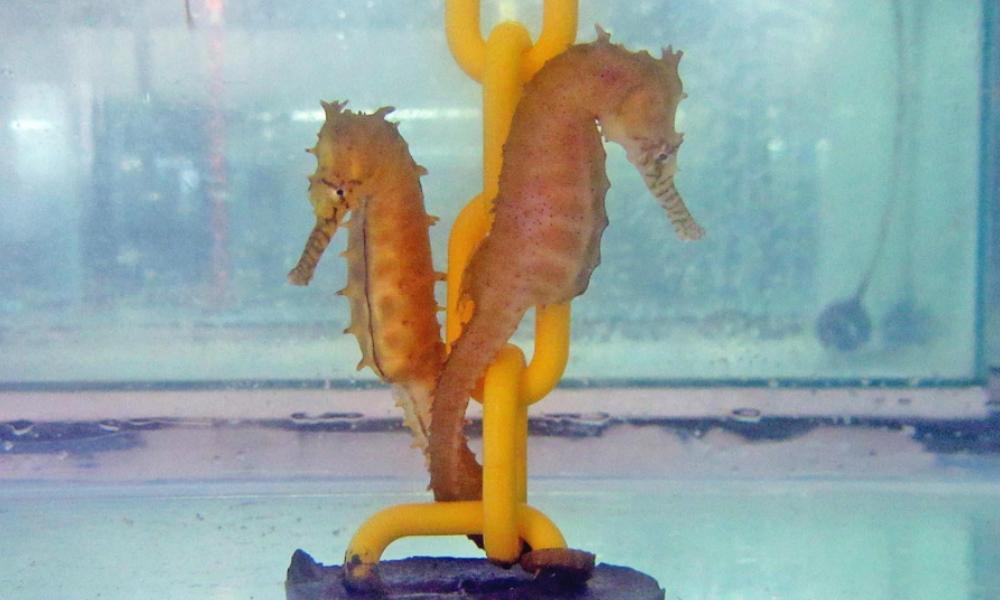
The fish comprise three species found in Malaysia – the highly-traded three-spot seahorse, spotted seahorse (Hippocampus kuda) and Barbour’s seahorse (H barbouri) – and the Australian/New Zealander big-belly seahorse (H abdominalis).
“We at FRI are focusing on seahorse aquaculture as an alternative to catching seahorses in the wild,” said Saupi. “Instead (buyers) can buy domesticated seahorses from the hatchery or aquarium shop.”
The strategy is to develop sustainable seahorse aquaculture as part of ornamental fish aquaculture.
In their 2020 resolution, IUCN had noted they are “troubled that aquaculture ventures for syngnathids often add to pressures on their wild populations”.
Saupi disagreed. “On the contrary, seahorse breeding will help to conserve the wild populations.”
Saupi has asserted that ultimately, the objective is “to have a system in case everything disappears from the wild”.
Ng’s approach towards seahorse conservation is to promote sustainable use.
As demonstrated by the seahorse’s widespread use in TCM alone, the fish is valuable not just for human health but as income for the traditional medicine sector and artisanal fishers.
Such uses – and therefore trade – are driven by culture, said Ng, adding that this was overlooked in the complexities of wildlife trade.
Shark fin soup
She pointed to the widely-known conservation sticking point of shark fin soup consumption by the Chinese. Its continued consumption is deeply rooted in Chinese culture.
“Then we (have to) question why the Chinese community values shark fin soup so much?”
To better understand the cultural drivers of seahorse use, Ng is also surveying fishers and the general public.
What makes Malaysia interesting for this is its multiethnic population, with Malays being the largest group in the peninsula and its largest coastal dwellers as well as sizeable ethnic Chinese, Indian and Orang Asli communities.
“We would expect that the usage of seahorses (by different groups) could be quite different,” said Ng.
Responses from her first 500 respondents already indicate this, differing by not just ethnicity but geography.
For example, Malays in the Klang Valley and the south use seahorses to treat the same ailments as TCM, particularly asthma, but in the north, Kedahans use them for lethargy and menstrual cramps.
In another example, wearing seahorses to ward off evil is practised among Malay fishers. At a Johor jetty, an Indian fisher ran home to get a seahorse amulet he used for the same purpose, to show Ng.
“Unfortunately, (research on) the cultural aspect of seahorse uses is lacking when, in fact, it is really important to inform effective and culturally-relevant or culturally-sensitive conservation and intervention measures,” she said.
This could come into play when suggesting alternatives to seahorses, for example.
Changes seem to be happening already in the centuries-old TCM practice in Malaysia.
“Generally speaking, seahorses are being used less and less (in TCM) and it’s not as easy to source them,” said Lock Fu Fah, a TCM practitioner of 10 years who was also interviewed by Macaranga.
As a result, Chinese medicine stores are stocking fewer seahorses.
Lock said modern physicians, who undergo a five-year university degree training, would seek alternatives. Lock himself prefers animal placentas and fenugreek seeds in place of seahorses.
However, in his view, “clinically, the traditional Chinese physicians use (seahorses) more”. Likewise, members of the public make their own home-based preparations.
Lock is concerned that the use of endangered animals like seahorses is unsustainable.
“In Malaysia, when TCM practitioners prescribe medicine, it’s usually for a few days, and each daily dose could contain 5 to 10 seahorses. Traditional TCM practitioners tend to use more. So for a week’s prescription, that would require 70 seahorses.
“(Luckily) there is a good trend in Malaysia (in that) we are using less and less of endangered animals in TCM here.”
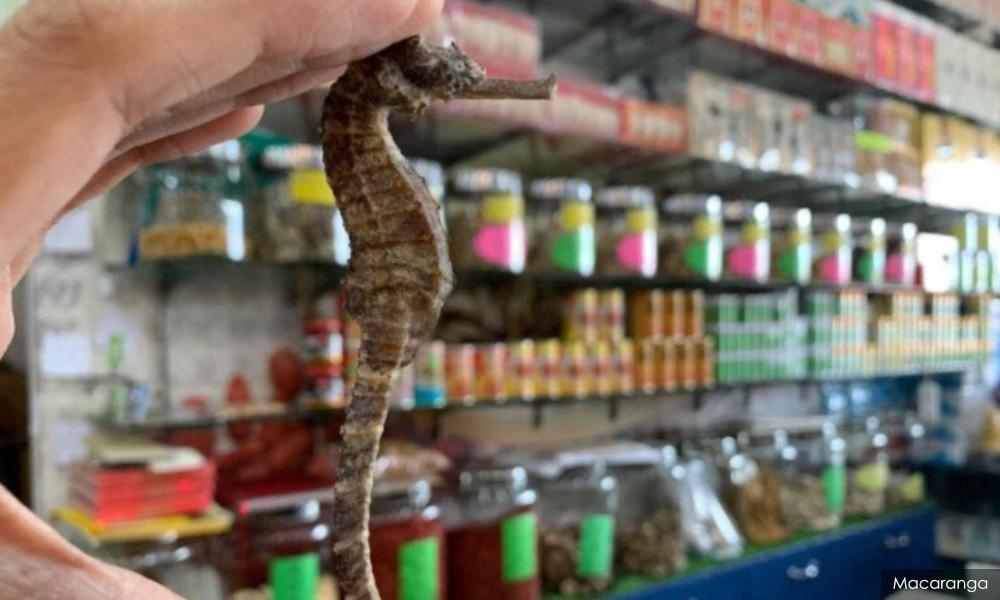
Ng’s TCM experience fortifies the need to work with seahorse users for conservation, rather than imposing restrictions such as banning the use of seahorses.
“It’s very hard to tell someone who has been using seahorses throughout his life, to just... completely stop,” said Ng. “It’s not going to happen, especially when it’s deeply rooted in culture…
“As conservationists, we must truly respect that.” As with any other conservation issue, “we’re just trying to work with people who trade in seahorses and use them to find a balance, so that seahorses can be used sustainably and legally.” - Mkini
This article was originally published on environmental journalism portal Macaranga. Law Yao Hua contributed to reporting for this story. With thanks to Reana Ng for sharing her data and Project Seahorse for use of the seahorse distribution base map. This story was made possible with support from Internews’ Earth Journalism Network.
The views expressed here are those of the author/contributor and do not necessarily represent the views of MMKtT.
✍ Credit given to the original owner of this post : ☕ Malaysians Must Know the TRUTH
🌐 Hit This Link To Find Out More On Their Articles...🏄🏻♀️ Enjoy Surfing!



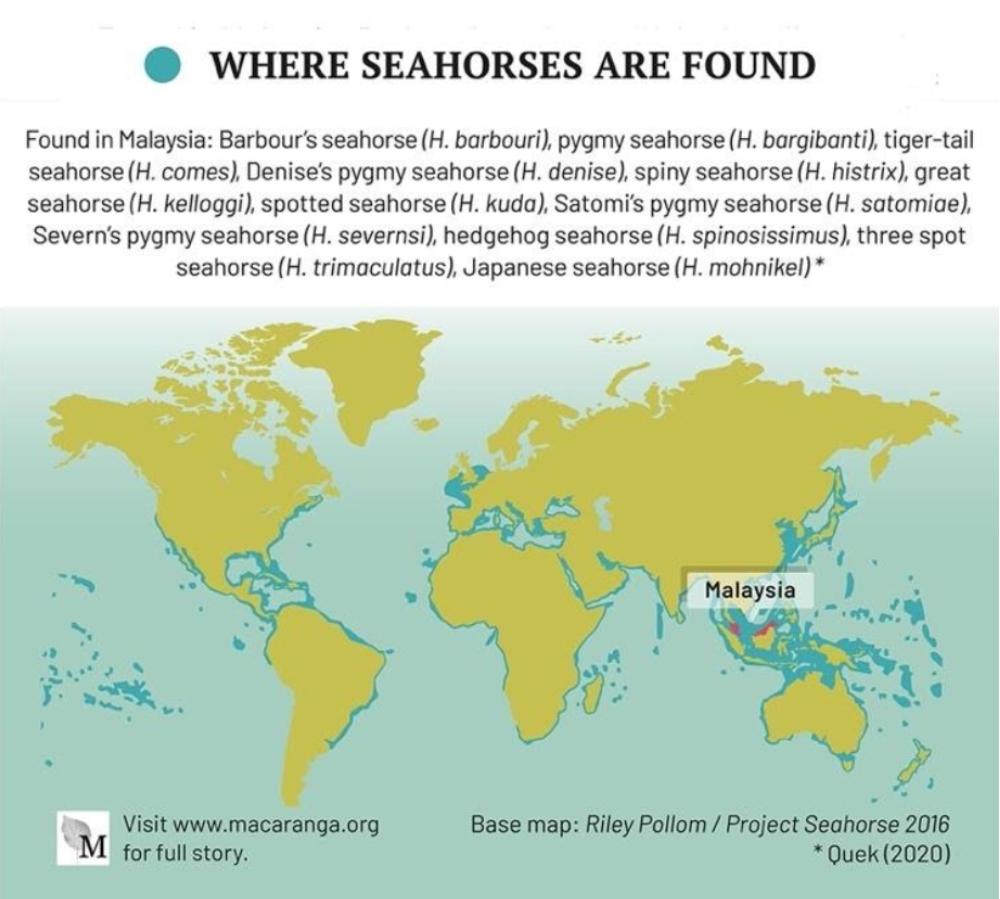

















Post a Comment